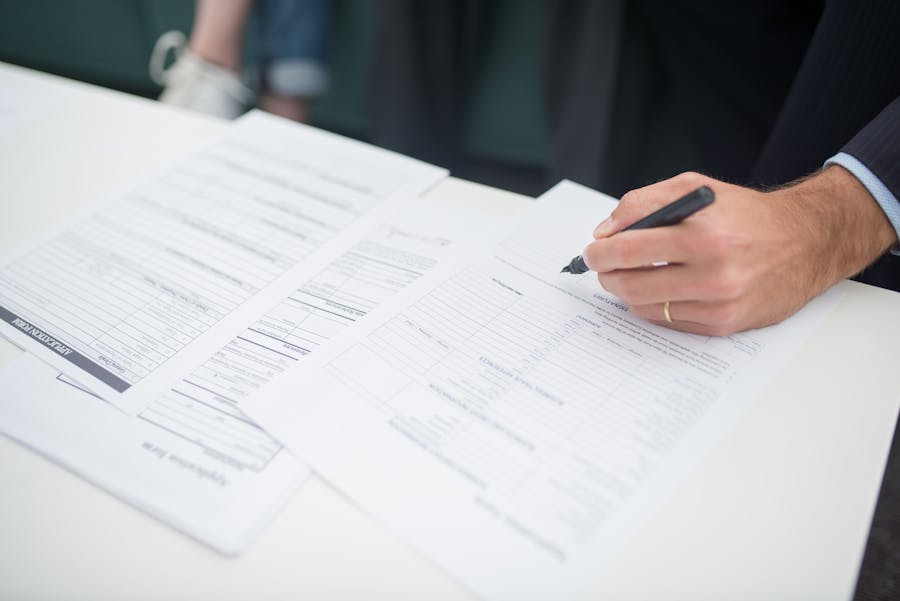How to Fill Out Form I-9: A Complete Guide for Employers in 2025

Are you a business owner struggling with Form I-9 compliance? You’re not alone. Many employers make errors when completing this critical employment verification document.
At De Wit Immigration Law, our Miami immigration attorneys regularly help businesses navigate employment eligibility verification. This guide breaks down exactly what you need to know about properly completing Form I-9 to maintain compliance and avoid costly penalties.
What Is Form I-9 and Why Is It Required?
Form I-9, Employment Eligibility Verification, is a mandatory USCIS document that verifies both the identity and employment authorization of all individuals hired for employment in the United States. Every employer must complete Form I-9 for each person hired after November 6, 1986, regardless of citizenship or immigration status.
The consequences of non-compliance are severe:
- First-time paperwork violations: up to $2,861 per violation
- Knowingly hiring unauthorized workers: up to $5,724 per unauthorized worker for first offenses, up to $14,308 per worker for second offenses, and up to $27,894 per worker for third or subsequent offenses
- Potential criminal charges, fines, and imprisonment for:
- Employers who engage in a pattern or practice of knowingly hiring or continuing to hire unauthorized workers
- False statements or document fraud
Form I-9 Completion: A Step-by-Step Timeline
Understanding the precise timing requirements for Form I-9 is essential for compliance:
| Phase | Deadline | Who Completes |
|---|---|---|
| Section 1 | No later than first day of employment | Employee |
| Section 2 | Within 3 business days of first day of work (or on first day if employment is “short-term,” i.e., less than 3 days) | Employer |
| Reverification | Before current work authorization expires | Employer |
Pro Tip: Employees can complete Section 1 after accepting a job offer, even before their actual start date.
Section 1: Employee Information and Attestation
The employee must complete Section 1 on or before their first day of work. Here’s what you need to ensure as an employer:
Required Information:
- Legal full name (including both last names if applicable)
- Other last names used (maiden names, previous married names)
- Home address (P.O. boxes are not acceptable)
- Date of birth
- Citizenship/immigration status attestation
- Signature and date
Citizenship Status Options:
- U.S. citizen
- Noncitizen national of the United States
- Lawful permanent resident (requires A-Number/USCIS Number)
- Noncitizen authorized to work (requires expiration date if applicable and one of three document numbers)
Common Section 1 Mistakes to Avoid:
- Missing citizenship/immigration status
- Incomplete alien registration number if applicable
- Missing signature or date
- Backdating the form (strictly prohibited)
Important: If an employee uses a preparer or translator, they must complete the Supplement A, Preparer and/or Translator Certification.
Section 2: Employer Documentation Review
As an employer, you must physically examine the employee’s documentation within three business days of their start date. This verification process includes:
Document Examination Process:
- Allow the employee to choose which acceptable documents to present
- Physically examine each original document (except certified copies of birth certificates)
- Verify documents appear genuine and relate to the employee
- Record document information accurately in Section 2
- Complete the certification with your signature and business information
Acceptable Document Combinations:
- Option 1: One document from List A (establishes both identity and work authorization)
- Option 2: One document from List B (establishes identity) AND one document from List C (establishes work authorization)
Most Commonly Used Documents:
List A (Identity and Employment Authorization):
- U.S. Passport or Passport Card
- Permanent Resident Card (Green Card)
- Employment Authorization Document with photograph
- Foreign passport with Form I-94 indicating work authorization
List B (Identity Only):
- Driver’s license
- State-issued ID card
- School ID with photograph
- Voter registration card
List C (Employment Authorization Only):
- Unrestricted Social Security card
- Original or certified birth certificate
- Native American tribal document
- U.S. Citizen ID Card (Form I-197)
Key Point: Never specify which documents an employee must present. This is considered discriminatory and violates federal law.
Correctly Entering Dates on Form I-9
Date formatting errors are common but easily avoidable:
Three Critical Date Entries:
- Employee’s first day of employment: The date the employee begins work for pay (can be current, past, or future)
- Document examination date: The actual date you physically examined the employee’s documents
- Certification signature date: Should match the document examination date
All dates must be entered in mm/dd/yyyy format. Never backdate any portion of the form.
Using Authorized Representatives for Remote Employees
With remote work becoming common, many employers need to designate authorized representatives to complete Form I-9 verification. Here’s what you need to know:
Who Can Serve as an Authorized Representative:
- Personnel officers
- Hiring managers
- Notaries public (acting as representatives, not in a notarial capacity)
- Any trusted adult (including family members of the employee)
Authorized Representative Requirements:
- Must physically examine original documents
- Complete all employer fields in Section 2
- Sign and date the certification
- Return the completed form to the employer
Important Note: While you can designate anyone to act as your authorized representative, you remain liable for any errors or violations they commit.
I-9 Reverification Requirements
Employment authorization documents with expiration dates require reverification:
When Reverification Is Required:
- Before the expiration of an employee’s work authorization
- When an employee presents a receipt and later provides the actual document
- When an employee’s name changes (documentation required)
Documents Not Requiring Reverification:
- U.S. passports and passport cards
- Permanent Resident Cards (Green Cards)
- List B identity documents
- Birth certificates and Social Security cards
Use Supplement B (formerly Section 3) for all reverifications and record the new document information and expiration date.
Form I-9 Retention and Storage Requirements
Proper retention of I-9 forms is just as important as proper completion:
Retention Periods:
- For current employees: The entire period of employment
- For terminated employees: Either 1 year after termination OR 3 years after the hire date, whichever is later
Storage Options:
- Paper storage (original forms)
- Electronic storage (must meet specific requirements)
- Microfilm/microfiche
Always ensure forms are stored securely but remain retrievable for government inspection with three days’ notice.
Common Form I-9 Mistakes and How to Avoid Them
Our experience at De Wit Immigration Law has shown these frequent errors:
Top Form I-9 Compliance Pitfalls:
- Missing information: Incomplete sections or blank fields
- Improper timing: Late completion of Section 1 or 2
- Document over-specification: Requesting specific documents from employees
- Acceptance of improper documents: Not verifying documents meet requirements
- Failure to reverify: Missing expiration dates for work authorization
- Inconsistent practices: Different standards for different employees
- Improper corrections: Using correction fluid or making illegible changes
Best Practices for Corrections:
- Draw a line through incorrect information
- Enter correct information
- Initial and date the correction
- Add a note explaining the reason for correction if necessary
How to Handle Special Situations
Different employment scenarios require specific approaches:
Minors (Under Age 18):
- Can provide school records if unable to present standard List B documents
- Still need List C documentation
- Parent/guardian can complete Section 1 for a minor
Employees With Disabilities:
- May have a preparer/translator complete Section 1
- Can present alternative List B documents if standard options aren’t available
- The form must indicate “Special Placement” in the Additional Information field
H-1B, L-1, and Other Visa Holders:
- Reverification is required before work authorization expires
- Monitor expiration dates carefully
- Some employment authorization documents may have automatic extensions
I-9 Compliance and E-Verify: What’s the Difference?
While related, Form I-9 and E-Verify serve different purposes:
Form I-9:
- Mandatory for all employers
- Paper or electronic process
- Verifies identity and work authorization
- Records remain with the employer
E-Verify:
- Optional for most private employers (mandatory for federal contractors)
- Electronic verification system
- Confirms information against government databases
- Requires Form I-9 completion first
Employers using E-Verify must complete both processes and follow specific rules, including requiring Social Security numbers in Section 1.
How De Wit Immigration Law Can Help Your Business
At De Wit Immigration Law, we help Miami businesses maintain I-9 compliance through:
Our I-9 Compliance Services:
- Comprehensive I-9 audits to identify and correct issues
- Custom compliance training for HR personnel
- Preparation for ICE inspections
- Defense against penalties and fines
- Development of compliant I-9 policies and procedures
Maintaining I-9 Compliance in 2025
Form I-9 compliance doesn’t have to be overwhelming. By following this guide and implementing proper procedures, you can protect your business while maintaining a legally compliant workforce.
For personalized assistance with Form I-9 compliance or other business immigration matters, contact De Wit Immigration Law in Miami to schedule a consultation. Our experienced immigration attorneys can help you navigate employment verification requirements and develop customized solutions for your business.
Remember: Proper Form I-9 compliance isn’t just about avoiding penalties—it’s about building a foundation for a legally sound and thriving business.





